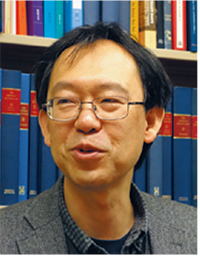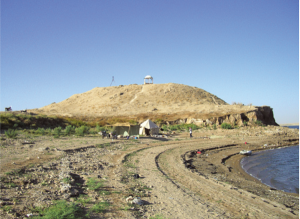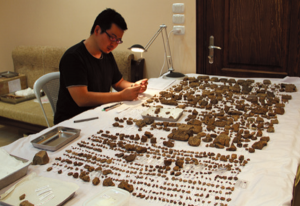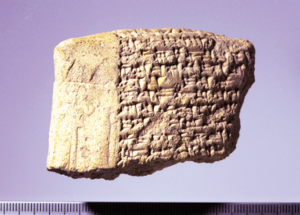キーワード: 古代西アジア、楔形文字学、アッシリア学、セム語学、メソポタミア
 今から約5千年前に現在のイラク南部で人類最古の文字システムが生まれました。葦で作ったペンで粘土板に書かれたこの楔形文字文書は、シュメル語、アッカド語、ヒッタイト語など多くの言語で書かれ、古代西アジアの人間社会の諸相を記録しています。西アジア地域に由来する、この楔形文字文書を中心に、古代オリエント(古代西アジア)の歴史・文化・言語を研究しているのが、リサーチユニット「古代オリエント」です。
今から約5千年前に現在のイラク南部で人類最古の文字システムが生まれました。葦で作ったペンで粘土板に書かれたこの楔形文字文書は、シュメル語、アッカド語、ヒッタイト語など多くの言語で書かれ、古代西アジアの人間社会の諸相を記録しています。西アジア地域に由来する、この楔形文字文書を中心に、古代オリエント(古代西アジア)の歴史・文化・言語を研究しているのが、リサーチユニット「古代オリエント」です。

図1:シリア テル・タバン遺跡(2010)
古代西アジアの世界に触れる

図2:柴田准教授 粘土板復元作業 シリア ハッサケ(2010)
本リサーチユニットでは、メソポタミアを中心とする古代西アジア世界の歴史、社会、文化、言語について、包括的に研究を行っています。現在、特に中心的に推進している研究は、①前二千年紀の北メソポタミアの社会と文化の研究、②前一千年紀の歴史と歴史記述の研究、③古代西アジアの諸言語の言語学的研究です。これらの重点課題は、粘土板文書など、原資料の体系的な分析に基づいています。
新文書の解読と研究

図3:テル・タバン出土養子縁組契約文書(前15~14世紀)
シリア北東部に位置するテル・タバンで発掘された粘土板文書を使って、紀元前2千年紀の上部メソポタミア社会の様子について研究を行っています。研究が進むと歴史、行政、法、政治、教育、宗教文化の詳細が明らかになります。
また、各種楔形文字文書の音訳を作り、英語の訳と訳注をつけていくことで、当該分野の歴史と文化の解明に取り組む世界中の研究者が利用できる資料集の作成を進めています。
社会への貢献・実績
- シンポジウム「クルド自治区(イラク共和国)における近年の考古学的調査」
(Recent Archaeological Research in Kurdistan-Iraq)」
2013年10月24日、筑波大学東京キャンパス122 講義室 - シンポジウム「西アジア・北東アフリカ史における「政治」と「宗教」」
2013年7月26日、筑波大学総合研究棟B108 講義室 - 国際会議:“ Cultures and Societies in the Middle Euphrates and Habur Areas in the Second Millennium BC: Scribal Education and Scribal Traditions”
2013年12月 5-6日、筑波大学筑波キャンパス - 国際会議:“ Interaction, Interplay and Combined Use of Different Sources in Neo-Assyrian Studies: Monumental Texts and Archival Sources”
2014年12月11-13日、筑波大学筑波キャンパスならびに筑波国際会議場
取材:平成27年1月8日
Ancient civilization studied with cuneiform documents
Unit name: Research Unit of the Ancient Near Eastern Studies
Key words: Ancient West Asia, Cuneiform studies, Assyriology, Semitic languages, Mesopotamia
 The world oldest writing system was developed in the southern Iraq approximately 5,000 years ago. The cuneiform texts written on clay tablets in Sumerian, Akkadian, Hittite, and other languages, using pens made of reeds, are records to present various aspects of the societies in Ancient West Asia. The research unit: “Research Unit of the Ancient Near Eastern Studies”, conducts research on the history, culture and languages of Ancient Orient (West Asia), its culture, and languages, focusing on the cuneiform documents discovered in West Asia.
The world oldest writing system was developed in the southern Iraq approximately 5,000 years ago. The cuneiform texts written on clay tablets in Sumerian, Akkadian, Hittite, and other languages, using pens made of reeds, are records to present various aspects of the societies in Ancient West Asia. The research unit: “Research Unit of the Ancient Near Eastern Studies”, conducts research on the history, culture and languages of Ancient Orient (West Asia), its culture, and languages, focusing on the cuneiform documents discovered in West Asia.

Figure 1: Remains of Tell Taban in Syria (2010)
Experience of the world of Ancient West Asia

Figure 2: Restoration of clay tablets by Professor Daisuke Shibata in Hassake, Syria (2010)
The research unit conducts researches on the histories, societies, cultures, and languages of Mesopotamia and other areas of Ancient West Asia. At present, our research focuses on: (1) The society and culture of North Mesopotamia in the second millenium B.C., (2) history and historiographic writngs in the first millenium B.C., and (3) linguistic studies of languages used in Ancient West Asia. These researches are based on systematic analysis of documentary source, mainly clay tablets with cuneiform texts.
Decipher of newly discovered documents and their research

Figure 3: An adoption contract excavated in Tell Taban (1,500 to 1,400 B.C.)
The unit studies ancient documents excavated in Tell Taban in the northeastern Syria to clarity the society of the upper Mesopotamia in the second millenium B.C. We examine the details of its history, administration, laws, politics, education, and religious culture.
We also transliterate the cuneiform texts adding critical notes to them to provide researchers around the world with basic research sources for the study of the history and culture of this area.
Social contributions and achievements
- Symposium “Recent Archaeological Research in Kurdistan-Iraq” held on October 24, 2013, in Lecture Room 122 on the Tokyo Campus of the University of Tsukuba
- Symposium “‘Politics’ and ‘religion’ in the histories of West Asia and Northeast Africa” held on July 26, 2013, in Lecture Room B108 on the general research ward of the University of Tsukuba
- International conference: “Cultures and Societies in the Middle Euphrates and Habur Areas in the Second Millennium BC: Scribal Education and Scribal Traditions” held on December 5 and 6, 2013, on the Tsukuba Campus of the University of Tsukuba
- International conference: “Interaction, Interplay and Combined Use of Different Sources in Neo-Assyrian Studies: Monumental Texts and Archival Sources” held on December 11 to 13, 2014, on Tsukuba Campus of the University of Tsukuba and in the International Congress Center in Tsukuba
Interviewed on January 8, 2015
